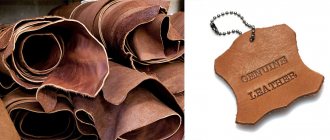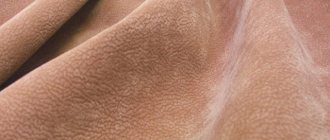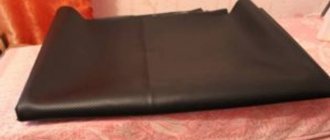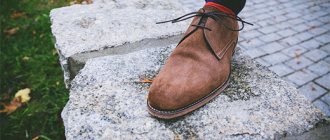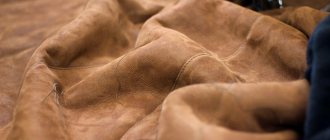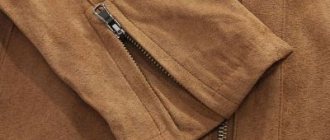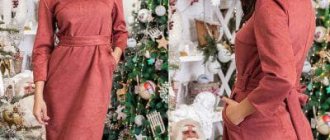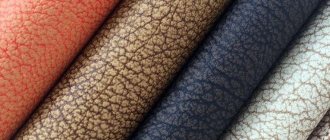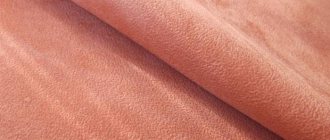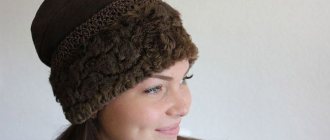Suede is a delicate and capricious material that does not lose popularity. Suede items look elegant, stylish and aesthetically pleasing. They are practical, comfortable and easy to wear. Soft, flexible and elastic, suede stretches and molds easily to the shape of your foot or body, allowing your skin to breathe and retaining warmth.
Unfortunately, under the guise of natural suede they sell cheap, less durable, practical artificial material. At the same time, due to modern processing and equipment, synthetics today differ little from the original in appearance, and at the same time they cost less.
However, it will last much less. In addition, artificial suede, unlike natural one, freezes, allows moisture to pass through, but does not allow air to pass through. Therefore, it is important to distinguish the original from the fake. In this article we will look at how to distinguish natural suede from artificial one.
Specifics and properties of natural suede
Suede is a type of genuine leather produced by fat tanning. There are two types of material. To obtain an unrefined variety, the skins of sheep and calves are used. Such skin is dense, but it is difficult to withstand mechanical stress.
The refined variety of suede is more in demand due to its softness and fineness. It breathes and is characterized by comfortable use. This material is obtained from the skins of goats and deer. In addition, vegetable fats are used in the production of the product, including flax oil, bone or fish oil.
To obtain natural suede, wool is removed from the skin, the remainder is greased and processed. When the fat is completely absorbed and becomes one with the protein of the skin, the material is painted and, if necessary, decorated. The result is high-quality natural suede with light fleecy, which is resistant to moisture and wear.
Despite its resistance to moisture and wear, the material requires careful care and use. Suede does not tolerate large amounts of moisture, so do not wear suede items in the rain. Do not dry products on a radiator or using electrical appliances; use special impregnations and sprays. How to care for suede items and renew suede, see here.
History of the material
Natural suede has a slight hairiness.
For the first time, suede began to be made in the 4th century AD. e. and since then it has not ceased to enjoy constant success among both fashionistas and lovers of comfortable sensations. It used to be that only outerwear, shoes, gloves and bags were made from suede, but today it is also used as upholstery material for furniture and sewing covers.
It is not known exactly where the name of this material came from, but there are two main versions:
- In Holland, in ancient times, goats were bred, from whose skin an unusually soft and beautiful material was made. They were called zeem.
- According to the second version, it is based on the French word chamois, which furriers in medieval France used to call specially tanned leather.
As a rule, suede is made from the skin of goats, deer, elk, calves and sheep.
Characteristics of artificial suede
Artificial suede is used to create budget and affordable shoes, clothing and accessories. The material is produced by two methods. In the first case, split microfiber threads are used, which make the product fleecy. The fabric is soft and pleasant to the touch.
In the second method, a polymer coating is applied to the fabric base and polished with a special laser. The result is an aesthetic and comfortable material, which is finally coated with a beautiful coating. However, artificial suede is not resistant to wear and abrasion, moisture and water, temperature changes, frost and heat. It does not allow air to pass through, which causes discomfort when using shoes and clothing.
Due to modern technologies and the processing of synthetic materials, it is becoming more difficult to distinguish between natural and artificial suede. In addition, the products are similar in appearance. We offer some tips to help you determine whether it is natural suede or not.
How to fake suede
Faux suede is produced in two ways: woven and two non-woven. The woven method of producing pseudo-suede is a fabric made from special microfiber threads and subsequent processing of the material. The first non-woven method involves gluing pile onto ordinary fabric. The second is to add looped threads, which then create pile.
Differences from nubuck and velor
Pay special attention to nubuck and velor. These are more affordable materials that are similar in appearance to natural suede. But the latter is flexible, elastic and soft. And the original retains these qualities even after getting wet and drying.
Velor and nubuck become hard and unpleasant to the touch. When wet and after drying, the fibers of such materials stick together, and the products lose their aesthetics and attractiveness. Traces and imprints remain on the surface, and creases in the pile form in different directions. Shoes made of velor or nubuck dissolve faster and last much less.
Velor is a dense and soft material with a velvety and fleecy surface. Unlike suede, it deforms when interacting with moisture and detergents. Velor is used for upholstery of upholstered furniture, tailoring, curtains and accessories, for the manufacture of car and furniture covers.
Velor has pile on only one side, while suede has pile on both. It has a solid color and fingerprints remain on the surface. The long and thick pile of velor easily changes directions, and the material itself does not bend and is cheaper. In addition, it wears out quickly and attracts dust, threads and hair. And creases easily form on the surface.
Nubuck is a thin and viscous material that, in a fairly short period of time, loses its physical properties, shape and presentable appearance. It is smoother and cheaper than velor and suede. Nubuck is used to make shoes and bags, various accessories, outerwear, and sometimes furniture.
Nubuck gradually wears out and becomes dull, and wear marks, stripes and cracks form on the surface. The life of such products can be extended with proper care and careful use. How to care for nubuck items at home, see the link.
Verification methods
If there is a sign No. 1 on the product, it means this is natural suede (leather)
Check No. 1: the cost of natural and artificial suede
Suede products, like leather ones, are more expensive than items made from substitute materials. Therefore, even at the largest sale, suede boots cannot be sold for next to nothing. But high cost does not guarantee the quality of the material. Therefore, before buying a new thing, it is worth subjecting it to a few more tests.
Check No. 2: by touch
Before purchasing a suede product, you need to feel it thoroughly with warm hands. Natural suede will quickly heat up and begin to radiate heat itself. If the item is made of faux suede, it will remain cold.
Check #3: Lint Test
The fibers of natural suede can be directed in any direction. At the same time, the shade of the product will change slightly. This will not happen with a counterfeit product. The villi will either not be manipulated, or the color will remain the same.
Check No. 4: color and texture
Faux suede
The uniformity of suede color is a wake-up call. Natural material cannot be perfect. There will definitely be microdamages on it, be it scratches, cracks or creases. If an item is absolutely uniform in color and texture, it is a fake.
Check #5: Elasticity
Natural suede is very elastic. After bending the material into a fold, a mark will appear on it. But it will quickly disappear, and the suede will return to its original form. Such an experiment will not work with artificial material: there will either be no trace of the fold at all, or it will appear and will not disappear.
Check #6: water
A drop of water is absorbed into the suede instantly. While artificial material is capable of holding a droplet on the surface for several seconds. Don’t be too lazy to take a bottle of water with you to the store and be one hundred percent sure of the quality of the item you like.
Check #7: smell
This method is more suitable for more experienced shoppers who know what genuine leather should smell like. After all, suede also has a subtle leather smell. And fake suede is usually odorless or smells like synthetics.
How to spot a fake
There are a number of qualities that are characteristic of real suede. These are the ones you should focus on when purchasing.
- Porous structure. Small cracks and scratches are easily visible on it, because it is made of animal skins. The fabric of artificial material is uniform in structure and perfectly smooth. It is difficult to find even minor imperfections in it.
- If you run your finger across the surface of expensive suede boots, you will leave a mark that is different in color from the area that was not touched. Streaks do not remain on artificial material.
- The natural material is velvety and soft, but not rough.
- High-quality shoes smell like leather, but substitutes have a synthetic aroma.
- If the back of the product is made of fabric, it is an ordinary fake.
- Natural suede costs more, but you shouldn’t focus only on cost. Unscrupulous sellers use various tricks to sell low-quality products at inflated prices.
- Water will help you distinguish a cheap analogue: real leather quickly absorbs moisture, after which wet spots will remain on its surface.
Having tested your favorite pair of suede shoes on the listed points, there should be no doubt as to whether they are made of genuine leather or artificial leather.
Description
Suede is a material made from the skin of animals, usually not large ungulates, of special manufacture - the canvas is devoid of a surface outer layer.
People learned to sew things from skins back in the Stone Age. The clothes were durable, warm enough, but heavy and uncomfortable. Over the course of thousands of years, humanity has improved methods of tanning and processing leather. The skins were tanned and treated with fats, including fish. Tanners from the Arkhangelsk and Novgorod regions were famous in Rus'.
But the development of suede leather technology belongs to the French. It is no coincidence that these people have always been distinguished by their refined manners, refined taste and desire for everything beautiful. The most delicate velvety skin was born in the early 1700s in southwest France. Suede immediately began to be in demand - products made from it were distinguished by style and comfort. True, only very wealthy people could afford such exquisite things.
Useful tips for choosing suede
Suede is a high-quality, but whimsical and expensive material. Therefore, you need to think a hundred times before purchasing something made from genuine leather. If you are purchasing suede for the first time, it is recommended to give preference to artificial material. It won't be such a shame if you can't properly care for the product.
There are some more useful tips for choosing suede:
- When purchasing a product, you need to pay attention to the lining . It must be movable, which will prevent deformation of the material.
- The natural product stretches well. Therefore, it is not recommended to buy things, especially shoes, clothes “to grow.”
- It is difficult to find suitable clothes for suede, so before buying you should think about whether there are suitable things in your wardrobe . Otherwise, expensive clothes will hang uselessly in the closet.
- The first “suede” purchase should be an accessory: handbag, gloves, strap, wallet. This will help you get used to the material and find out if it is right for you.
Attention! When purchasing, you need to pay attention to how the products are stored. There must be a special filler inside the shoe to prevent deformation. Clothes should hang on hangers.
If a person prefers to wear clothes made of suede, this speaks of his impeccable taste. Well-groomed, clean things bring joy to the owner for many years and allow him to stay warm in cold weather and increase his status in the eyes of those around him. What to choose, a natural product or synthetics, is a personal decision of each person, in which material capabilities play a large role.
Where is it used?
The scope of application is wide: from sewing clothes to making upholstery for furniture and covers for cars. It all depends on the base on which the pile is glued.
Cotton-based fabric is denser and is used for sewing winter and autumn outerwear, as well as bags and shoes. Suede fabric on a knitted basis drapes well, so it is suitable for making skirts, dresses, and jackets.
Depending on the base, several varieties of this material are distinguished. If spandex or other elastic synthetic fabric is used as a backing for gluing the fibers, then stretch suede is obtained. This is a material that stretches in all directions and whose properties resemble natural leather.
When sewing upholstery for car seats, self-adhesive Alcantra suede is used, which is obtained using a non-woven method. Today it is the most inexpensive and high-quality upholstery material in the world, which is many times superior to leather.
Advice. To give the finished product a slight shine, when cutting the fabric, place the pile down, and to obtain a brighter color, the piles should “look” up.
For information on how to properly wash and iron this material, read the article “Suede Fabric: Care at Home.”
This video features a suede skirt, dress and jacket! Attention! Video in English!
What is it like?
Natural suede is leather that is tanned by impregnating raw, pre-prepared hides with fats. The high-quality material feels very soft and velvety to the touch.
Faux suede is a fabric impregnated with rubber glue with a suede-like pile. Sometimes it is made by coating the material with glue and sprinkling cotton fiber on top.
Products made from suede are lightweight. They have good breathability and are equally suitable for sewing clothes and making shoes. Suede items are distinguished by their strength and durability.
Natural suede is noticeably superior in price. This is due to the longer, more complex and labor-intensive process of manufacturing the original material. Buying shoes made of artificial leather at the price of natural leather is a very shame. Therefore, fans of “fleecy” shoes need to be able to distinguish a fake so as not to fall into the trap of unscrupulous sellers.
Do you wear suede shoes?
Yes
No
Suede care
Rules for caring for suede items:
- It is advisable not to wear clothes and shoes made of suede in rain or in heat above +35 °C. If you still have to wear it, then before a walk it is recommended to treat the textiles with special sprays or creams.
- Natural fabric does not tolerate washing - dry cleaning is preferable. Small stains are wiped with a napkin to prevent them from spreading. Grease stains are sprinkled with talc powder and left for 2-3 hours. Persistent, extensive stains are sprayed with a mixture of ammonia and soapy water (proportion – 4:1) and treated with a soft brush. Salt stains are moistened in a solution of 9% vinegar.
- Suede shoes should be cleaned after every trip outside. If there is still wet dirt or sand on it, you should first wait for it to dry completely. For cleaning, a special brush with soft brass bristles is used. Any remaining stains after initial treatment can be removed with a damp sponge.
- Products should be dried at room temperature, preferably flat (for example, on a hanger). Do not leave suede items near a radiator, radiator or in direct sunlight.
- You should not iron suede clothes. Just straighten things out and leave them for 20-30 minutes – they will regain their shape. If necessary, remove wrinkles with a soft brush. To maintain the shape of the shoes, folded newspapers, cotton wool, fabric or special fillers are placed inside.
- Furniture covers are regularly treated with soapy water. After cleaning, wipe them thoroughly with a dry cloth or towel and dry them so that no traces of moisture remain. Then protective agents are applied.
In order for suede products to last longer, they must be periodically treated with compounds to nourish, moisturize, and restore color. This will help preserve not only the original appearance, but also the elasticity of things, and protect them from damage and wear.
Consumer properties
Characteristic features that distinguish split velor from other similar materials:
- delicate pile that changes direction when touched;
- velvety front side without pores and smooth back side;
- ductility, the ability to take the desired shape;
- uniform structure, uniform color (both natural and dyed);
- folding the cut edge when sewing;
- the lowest price among fleecy leathers.
| Differences between split velor and other materials with pile: | |
| Suede | Less expensive to produce. It is produced by chrome tanning, not fat tanning. Easy to paint. During the tanning process with chemicals, it loses its hypoallergenic properties. Has longer pile. Due to the thinness of the fabric, it allows the production of small products. It is inferior in strength, stretches more and allows moisture to pass through, but suffers less from the action of chemical reagents. |
| Nubuck | It is produced from the middle layers of the skin, not the top. Tanning uses predominantly chromium rather than mineral salts. Due to its greater ductility, it is easier to wear, taking the shape of the legs. Less strong and durable. Thanks to its smaller thickness, it dries faster when wet and absorbs moisture-proof compounds better. |
Compared to other raw hides, split velor has both advantages and disadvantages:
| pros | Minuses |
|
|
Advantages and disadvantages
This artificial fabric has significantly more advantages than disadvantages. Let's look at everything in order.
Pros:
- As furniture upholstery, it is equally good for any interior style, be it classic or avant-garde. Its versatility is also evident in the successful use of suede both at home and in the office.
- Increased resistance to deformation and abrasions is another advantage of suede upholstery. Such sofa clothing will not crack or stretch under increased load, which its natural counterpart cannot boast of.
- The material does not accumulate static electricity.
- Artificial furniture suede has the same density throughout the entire perimeter, unlike natural one.
- The fabric is resistant to direct sunlight.
- This upholstery does not stick to the body.
- An interesting property of artificial suede for furniture: it gives warmth in winter and coolness in summer.
- The same goes for suede clothing. The skin in such clothes breathes.
- Faux suede is easier to clean thanks to the Teflon impregnation with which they are treated.
- This material looks no less aesthetically pleasing and attractive than the real thing. Its iridescent velvety surface attracts the eye.
Minuses:
- Fabric has limits. For example, it does not stand up to being used as a scratching post. Keep animals away from this upholstery.
- Light-colored material tends to get dirty quickly. The problem can be solved either by frequent cleaning or by a removable cover.
- Caring for faux suede is not easy. This material does not tolerate high humidity. Only dry cleaning or a minimum of water (solutions of ammonia or vinegar) is allowed.
Basic rules on how to distinguish natural material from artificial
To check the naturalness of the material, you can conduct several tests. They are quite simple and can be made right at the point of purchase.
- Take the product in your hands. Whether it's shoes or other products, touch the surface with your palm. The natural base is cold, but it will quickly warm up from the warmth of your hand, the artificial one will be warm initially and will not change the temperature.
- Press your fingers into the surface. On a substitute, fingerprints are more visible and will remain for a longer time.
- Apply a small drop of water. A natural base will quickly absorb moisture; with an artificial one, it will simply slide off.
On a note! The best way to determine naturalness is by touch.
To the touch, natural suede is elastic, cold, soft, somewhat reminiscent of rubberized leather, the pile is very short, so the surface is almost smooth.
DIY autumn dress
How to clean white suede
